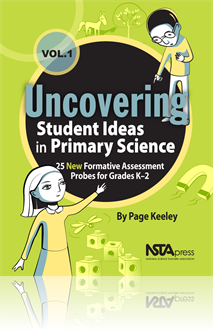All Physical Science resources
Journal Article
Scope on Safety: Wave Warnings
This column shares safety information for your classroom. This month’s issue discusses safety when using equipment that is used to provide students with a better understanding of light, sound, and wave energy....
NSTA Press Book
Winner of the Distinguished Achievement Award from PreK-12 Learning Group, Association of American Publishers!What ideas do young children bring to their science learning, and how does their thinking change as they engage in “science talk”? Find...
By Page Keeley
Book Chapter
The purpose of the assessment probe, in this chapter, is to elicit children’s ideas about variations in sound. The probe is designed to reveal students’ thinking about factors that affect pitch....
Journal Article
Incorporating Models Into Science Teaching to Meet the Next Generation Science Standards
Discover what the NGSS has to say about the proper use of models in the middle school classroom....
NSTA Press Book
Even More Picture-Perfect Science Lessons: Using Children’s Books to Guide Inquiry, K–5
Winner of the Gold EXCEL Award from Association Media & Publishing!“The number one compliment we hear from teachers is that the lessons are complete and ready to take back to their classrooms and use.” —Emily Morgan and Karen Ansberry, coautho...
By Emily Morgan, Karen Ansberry
NSTA Press Book
Teaching Science Through Trade Books
“‘What was your favorite book as a child?’ In more than 10 years of facilitating workshops, we have never heard anyone reply, ‘My fourth-grade science textbook.’ Clearly, textbooks have an important place in the science classroom, but usin...
By Christine Anne Royce, Emily Morgan, Karen Ansberry
NSTA Press Book
Companion Classroom Activities for Stop Faking It! Force and Motion
Never has it been so easy for educators to learn to teach physical science with confidence. Award-winning author Bill Robertson launched his bestselling Stop Faking It! series with Force and Motion—offering elementary and middle school teachers a j...
By William C. Robertson, Ph.D.





